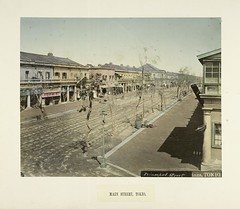From the New York Public Library collection of Kusakabe Kimbei prints.
Main Street, Tokio
It's got three captions, two overlapping. "inza" can only mean "Ginza". And while there may be 400 Ginza neighborhoods across Japan, there's only one that is the "Princepal" or main street in Tokio -- er, Tokyo.
This is the famous Renga-gai - bricktown or brick street - in Ginza, Tokyo. It was an experiment at completely redeveloping one of Tokyo's tinderbox neighborhoods in fireproof brick. In 1872 yet another massive fire spread through Tokyo. Ginza Renga-gai was completed in 1877, designed by British architect and engineer T J Waters (Japanese).
The street itself was a first for Tokyo. Pedestrian areas are separated from wheeled traffic, and gas lamps light the road at night. Arcades visibile on the opposite side of the street were copied from Tuscany, while the entire street sceen evoked Regents Street in London.
Unfortunately Waters' northern design skills created buildings that baked their occupants in Tokyo's hot summer months. The street itself flooded horribly in Tokyo's typhoon season. The brick neighborhood was not expanded beyond Ginza, for these reasons or perhaps simply because it was too abnormal for Japanese people to live in.
It lasted until the 1923 earthquake.
(I got most of that info from a great intro architecture book, I just reviewed it.)
I found the same photo on Meijitaisho.net, which dated it as 1877 - makes sense since the trees are still scrawny. They point out the Hattori Watch Shop (服部時計店) on the left which closed in 1894. They also notice the very top of the tower of Asano News (朝野新聞社社屋) jutting above the watch shop.
This photo predates the streetcar line visible in the Edo-Tokyo Museum model. The horse-drawn streetcar was installed in 1882.
The photo location is pegged by Meijitaisho.net as looking north from the Ginza-8 intersection, underneath the Capital Expressway. Here.
(parts of this post is also on the Flickr Commons discussion group)

